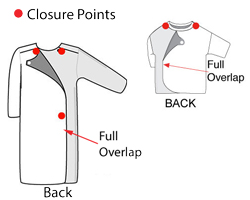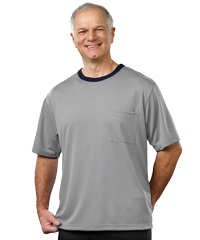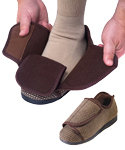Adaptive Clothing

People with disabilities due to disease or injury, physical limitations in range of motion or those who are aging naturally often will have trouble at some point in their lives getting dressed and undressed. Clothing manufacturers normally design their products for fully abled people who are more interested in the look of the item than the ease of wearing it. Normal clothing is not designed with the ability of the wearer to dress themselves taken in to account.
For those who have trouble bending, reaching and flexing their limbs due to age, dressing can be a stressful and difficult task. For those with limbs that can't be controlled or don't function at all the act of getting dressed can be impossible. For those who are confined to a wheelchair the task of getting pants or dresses on usually requires the help or one or more caregiver.
The Solution
Several companies have developed lines of clothing that are designed to be put on and removed while seated or lying down and to provide some measure of independence for the user who is able to dress themselves.
Among the products available for those who require clothing that is easy use are these:
Men's Wear

- Men's dress shirts with magnetic closures instead of buttons
- Men's Polo, Tee & Undershirts that are open at the back with large flaps and close at the shoulders
- Cardigans with snap back dome closures
- Men's underwear that closes at the sides using Quick Strip closures and pull tabs to unfasten
- Men's pants that close at the sides using VELCRO® brand fasteners
- Socks with pull loops and non-slip soles
- Shoes and slippers with hook and loop closures and non-slip soles
Women's Wear

- Women's dresses, tops and blouses that are open at the back with large flaps and close at the shoulders
- Bras with front closures using hooks, snaps or VELCRO®
- Women's underwear that closes at the sides using Quick Strip closures and pull tabs to unfasten
- Women's pants that close at the sides using VELCRO® brand fasteners
- Socks with pull loops and non-slip soles
- Shoes and slippers with hook and loop closures and non-slip soles




Tips for Dressing Others
TIP #1: Start by dressing the person's affected/weaker side first. When undressing, remove the unaffected side first.
TIP #2: Ask residents if they want help picking out their outfits or if they want you to do it. This provides them a sense of independence and choice. Provide a few options of outfits for them to choose from if they want to be involved.
TIP #3: When dressing a person in bed sit the head of the bed up. This gives their back muscles a chance to adjust to the upright position and gets their blood flowing. Put on their socks, pants, shoes, and so on. Aside from being easier on the resident, it will protect your back.
TIP #4: Not everyone is going to be happy to have help getting dressed. If you have a difficult resident, positive reinforcement, smiling, and a good attitude go a very long way.
TIP #5: Tell the person you're dressing what is happening every step of the process, especially if the residents are confused. It keeps them in the loop, builds trust, and makes them more comfortable.
TIP #6: The most simple tip, but possibly the most important, be patient!
Note: Many of the images and much of the information I've presented on this page have been provided by Adaptiveclothes.com.


 Online Vendors
Online Vendors  US Online Vendors
US Online Vendors 
